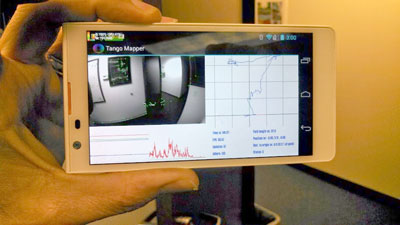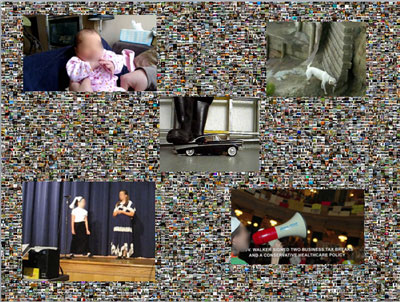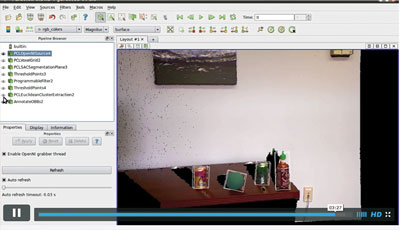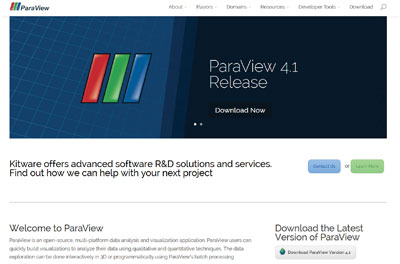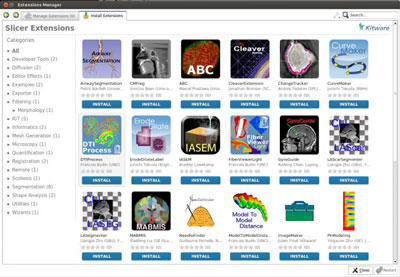Kitware News

Google Tango Data Visualization
Kitware announced the release of a tutorial that describes how to use ParaView to extract, process, and visualize data from Google Project Tango development kits. The purpose of the tutorial is to promote faster development of the open Project Tango platform. The tutorial is published on Kitware's blog.
Using the plugin and visualization capabilities of ParaView, users can interact with their Project Tango data without having to write a single line of code. For those who do not have Project Tango Development kits, the tutorial provides links to download sample data.
The process starts with gathering data from the devices using the Android SDK. Then, this data is read into ParaView using a Tango-specific data plugin that is available as an open source download. The data is by nature 3D+time, meaning that it is a sequence of point clouds acquired over time. This data includes readings of the device position and orientation in 3D space, which indicate where the device was and the direction in which it was pointing at the moment a particular point cloud was acquired.
After being loaded into ParaView, the point clouds are aligned and stitched together. ParaView can then use its animation capabilities to display the intermediate point clouds and how they contribute to reconstruct a larger area of space around the device. Filters are available from the Visualization Toolkit and the Point Cloud Library for advanced analysis. Example data sets are available for download on the MIDAS platform, along with installers for the customized ParaView builds for Windows, Linux, and Mac.
Kitware will continue exploring the use of the Project Tango devices for engineering, simulation, measurement, and medical applications.
KWIVER WAMI Tracking System Released
Kitware announced the immediate availability of its state-of-the-art Wide Area Motion Imagery (WAMI) tracking system on Forge.mil, as part of the Kitware Image & Video Exploitation and Retrieval Toolkit (KWIVER). Full source code is available with unlimited rights, under the conditions of the DoD Community Source Usage Agreement, to anyone who can access Forge.mil.
Developed with funding from the Defense Advanced Research Projects Agency (DARPA) and the Air Force Research Laboratory (AFRL), Kitware’s WAMI tracker in KWIVER is capable of producing tracks in real-time from WAMI across a wide range of resolutions and frame rates, by dynamically distributing processing across a compute cluster. The resulting data assists intelligence analysts as they support military operations, both live and forensically. Recently, Kitware's WAMI tracker was successfully transitioned to theatre as part of the Air Force's intelligence, surveillance, and reconnaissance system, where it produced tracks on downlinked WAMI in real-time.
Forge.mil is the Department of Defense’s (DoD) collaborative, government-open-source software hosting and development site supporting the technology development community. Membership in Forge.mil is available to DoD military and civilian employees and to DoD contractor personnel. By making Kitware’s tracking system available on Forge.mil, Kitware is providing the DoD software development community the opportunity to review and use the operationally deployed software under a Government Purpose Rights license.
By placing its tracking technology on Forge.mil, Kitware is following its company-wide commitment to open-source software and scientific collaboration. Kitware intends to work with government and government contractor personnel to enhance the system and to help deploy its capabilities as part of other government projects. In addition to tracking technology, Kitware plans to add analytics to KWIVER from previous and ongoing government efforts. It is hoped that a software and algorithm development community will form around KWIVER, such that contributions from performers, government labs, and academia can be combined to create the best possible video analytics, freely available to everyone working with and within the US government.
This work is supported by DARPA and AFRL.
Approved for Public Release, Distribution Unlimited.
Lightning Talk Presented at GEOINT
At the 10th annual Geospatial Intelligence (GEOINT) Symposium, Matt Turek, Kitware's Assistant Director of Computer Vision, presented new technology being developed at Kitware that addresses the challenges of analyzing crowdsourced multimedia. The lightning talk, "Large-Scale Understanding of Crowdsourced Multimedia Relationships," detailed approaches that would enable analysts to more efficiently evaluate large-scale multimedia collections, such as YouTube videos, for salient information. Kitware's solutions center on automatic video grouping based on semantic concepts and interactive multimedia organization.
This technology represents some of the cutting-edge research being done by Kitware's Computer Vision team. In addition to providing solutions to the GEOINT community, Kitware has developed and deployed operational solutions to support other intelligence communities, including a WAMI tracker successfully transitioned to theatre.
Matt's talk focused on understanding Internet video relationships. In particular, he discussed complex events; people, places, and things; and indicators of population sentiment.
New Capabilities Added to WAMI Utility
Automatically detecting objects such as people and vehicles performing specific functions or complex activities is one of the most challenging problems in video analytics. Complex functional object recognition is required to detect objects that are defined by their behavior rather than their appearance, such as delivery trucks, police patrol vehicles, buses, and road cleaning vehicles. It is also used to detect complex threat patterns such as IED emplacement.
During Phase II of the project "Vision with a Purpose: Inferring the Function of Objects in Video," Kitware created a prototype demonstration system to capture the power of human intuition by having users define complex functional objects' components, as well as the components' relationships, in a new graphical model. The model is then used to automatically and efficiently scan vast video scenes over long periods of time. In addition, the workflow enables users to share feedback to improve results. When example videos of functional objects are available, the system can also learn the core characteristics of their activities using machine learning techniques. The capability can be applied across diverse domains including wide-area motion imagery (WAMI), aerial full-motion video, and ground surveillance video.
The research and development conducted for the workflow has produced crucial state-of-the-art technologies for vision-based recognition of functional objects. The core capabilities of these technologies include learning functional object models from examples using machine learning techniques, detecting known functional objects using a complex activity model, detecting anomalous functional objects, modeling relationships between locations and movers, and analyzing multi-scale patterns of life.
The project's developments add new dimensions to the utility of WAMI videos and should play a crucial role in advancing the technologies utilized for national security and defense.
This material is based upon work supported by the Defense Advanced Research Projects Agency (DARPA) under Contract Number W31P4Q-10-C-0262.
Approved for Public Release, Distribution Unlimited.
Point Cloud Processing Highlighted in Demonstration
Casey Goodlett attended the Triangle Python Users Group Meeting held in Carrboro, NC, where he presented a talk on "Python Scripting of ParaView with Application to Point Cloud Processing." The talk detailed use cases in point cloud processing to exemplify how Python can be used to implement domain-specific visualization and processing routines. More information on ParaView and point cloud processing can be accessed on ParaView's Wiki page.
As part of his talk, Casey presented a live demonstration that showed the use of Python and ParaView's Point Cloud Library plugin for the processing of Kinect data. In the video, ParaView is used to interactively build a pipeline of Point Cloud Library filters to segment objects sitting on a tabletop, as is shown in the image below.
NCIP Repositories Converted to Git
Kitware announced the successful completion of its participation in the National Cancer Informatics Program (NCIP) Open-Development Initiative. Dr. Luis Ibáñez and Dr. Brad King led Kitware's efforts on this initiative, which included advising Leidos Biomedical Research, Inc., on converting its many public source-code repositories from Subversion (SVN) to Git and assisting in the transfer of the repositories to the GitHub hosting platform. Leidos Biomedical Research, Inc., formerly known as SAIC-Frederick, operates the Frederick National Laboratory for Cancer Research on behalf of the National Cancer Institute (NCI).
As part of this effort, 156 repositories were converted to Git and transferred to GitHub with 135 of these repositories located on the NCIP's main website. The remaining repositories can be found on remote sites, including the eXtensible Imaging Platform (XIP). The repositories contain tools that aid in biomedical research activities such as genome sequence analysis, enterprise-wide bio-banking, integration of translational research, radiologic imaging, and clinical trials management.
Dr. King led Kitware in converting projects related to the NCIP's caTissue platform to Git. In total, this platform consists of approximately 20 repositories.
The $77,629 used for the project was funded by NCI Contract No. HHSN261200800001E.
Three GSoC Projects Accepted for VTK
Three of the accepted Google Summer of Code (GSoC) 2014 projects were proposed for the Visualization Toolkit (VTK).
"Ensemble Vector Fields for VTK" was proposed by Brad Eric Hollister, who is working with Kitware's Berk Geveci. To add visualization support for ensemble vector fields, Brad plans on performing several tasks for the project. The first is "loading ensemble data from the NetCDF file format. The second is computation of finite-time variance analysis (FTVA) for an EVF. The third is to provide visualization of clusters in the variance data from FTVA. Lastly, as an optional item if time permits, is the inclusion of TRACLUS, a trajectory clustering algorithm for use within VTK."
"Extensions for Geospatial and Climate based visualizations in VTK" was proposed by Jatin Parekh. For the project, Jatin is working with Kitware's Aashish Chaudhary. The goal of the project involves "adding a few extensions to the VTK library to support Geospatial and Climate based visualizations in the VTK library. The proposed work can be divided into four tasks: 1) Add new features to existing filters such as neat labelling of the contours. 2) New readers to read LIDAR dataset and GeoJSON geometry data into VTK. 3) Improve handling of time in VTK. 4) Implement tile rendering in VTK (optional – time permitting)."
"Supporting a Visualization Grammar" was proposed by Marco Cecchetti. The goal of the project is to "provide the ability to create plots and charts with the VTK framework by a simple declarative language. In order to achieve this goal a visualization grammar similar to the one utilized by the Vega JavaScript library will be mapped to VTK data structures and to specific classes that will be designed for supporting geometry objects and marks." Marco is working with Kitware's Jeff Baumes for the project.
For more information on these projects and details regarding VTK's participation in the program, please visit the Google Summer of Code 2014 website.
New .Org Websites Unveiled
Kitware announced the rollout of the new ParaView, Open Chemistry, and Tangelo websites. The website designs are intended to better serve the ParaView, Open Chemistry, and Tangelo communities by making it easier to provide more dynamic and up-to-date information, being mobile-friendly, and helping new users become familiar with and start utilizing the software.
Each website includes a full-page examples/image gallery and a quick access download button on the main page.
ParaView, Open Chemistry, and Tangelo are the first of the open-source project websites that Kitware manages to be transitioned to the new design. Kitware is continuing the process of transitioning additional websites and will announce their rollouts as they occur.
To provide feedback on the updated websites, please contact comm@kitware.com.
ParaView Spotlight: Show off your vis!
We’re looking for exciting new visualizations (images or movies) to include with the ParaView showcase we’re hosting at SC14 and the new paraview.org. Show off how exciting your data and research is, and have your visualization featured! To make it in time for SC14, we’ll need all submissions by October 1st. For details on how to submit, including specs, check out the “what’s new” feature on paraview.org.
To make a contribution to the new paraview.org, please e-mail dave.demarle@kitware.com and comm@kitware.com.
Opensource.com Community Awards Received by Members of Kitware
Kitware is pleased to congratulate Luis Ibáñez and Marcus D. Hanwell on their Opensource.com Community Awards.
Luis won a Reader's Choice Award for his article "University course trades textbook for Raspberry Pi." The award is granted to an article written in 2013 that is determined by vote to be an Opensource.com community "favorite." The article describes how the use of Raspberry Pi has taken the place of textbooks in the course Information in the 21st Century at the State University of New York at Albany. Luis also received a Social Sharer Award for his excellence in sharing Opensource.com articles online.
Marcus won a Conversation Starter Award for his achievement in beginning conversations on Opensource.com posts. Marcus became an Opensource.com Community Moderator earlier this year. As a member of the Opensource.com community, Marcus writes about a diversity of topics including open-source tools, events, and publications.
Kitware Actively Involved at SciPy 2014
Kitware attended the 13th annual Scientific Computing and Python (SciPy) conference, which occurred from July 6 to July 12, 2014. The conference, hosted by members of academic, commercial, and government organizations, was dedicated to the "advancement of scientific computing through open-source Python software for mathematics, science, and engineering."
Not only was Kitware a Silver sponsor of the event, but Matt McCormick and Aashish Chaudhary served as members of the SciPy Program Committee.
In addition, Kitware demonstrated its diverse scientific computing capabilities in areas such as geospatial dataset visualization, climate model analysis, and cross-platform builds across HPC, desktop, and mobile platforms by participating in several activities including presentations, developer sprints, and Birds-of-a-Feather (BOF) sessions.
Hackathon for Dermatology Image Repository Hosted at Kitware
In collaboration with the Memorial Sloan Kettering Cancer Center (MSKCC) and the IBM Watson Research Center, Kitware hosted a Hackathon on Large-Scale Dermatology Image Repository earlier this year.
MSKCC – the world's oldest and largest private cancer center – has devoted more than 130 years to exceptional patient care, innovative research, and outstanding educational programs.In this collaboration, MSKCC is pursuing a large-scale data sharing initiative through which thousands of dermatological images will be publicly shared with the goal of furthering cancer research. This large collection of images will include annotations and metadata that will empower researchers to apply data analysis techniques to better understand the onset and evolution of skin cancer. IBM Research is playing a scientific role in researching algorithms to support the diagnosis of melanoma detection.
Among the topics discussed at the hackathon were overarching plans for data sharing, software platforms for the image repository, software tools for image annotation, methodologies for detecting skin cancer by computing changes between images and baselines, integrating images into Electronic Medical Records (EMR), and licensing terms to ensure that data for the Dermatological Image Repository will be made available in the Public Domain.
Kitware Participates in Bike to Work Challenge
Kitware once again brought home the Gearhead trophy for highest participation (for organizations with more than 10 employees) in the Saratoga Bike to Work Challenge, which occurred on May 16, 2014. In total, 14 members of Kitware participated in the challenge.
In addition, Chris Harris won the Fork in the Road trophy for the longest commute at 49 miles round trip.
Tutorials, Talks, and More Presented at CVPR 2014
Kitware actively participated in the Computer Vision and Pattern Recognition (CVPR) 2014 Conference, which was held from June 23 to June 28, 2014.
Dr. Anthony Hoogs presented a talk titled "Video Scene Segmentation and Recognition by Location-Independent Activity Classes" at the Workshop on Perceptual Organization in Computer Vision. This is a workshop on segmentation.
Eran Swears presented a poster, which covered the paper "Complex Activity Recognition using Granger Constrained DBN (GDBN) in Sports and Surveillance Video," during the main conference. He also presented his ICCV 2013 paper, "Pyramid Coding for Functional Scene Element Recognition in Video Scenes," as a poster at the Scene Understanding Workshop.
In addition, Eran presented his dissertation at the Doctoral Consortium, a competitive program where Ph.D. students who are close to graduation are paired with senior
researchers for career and technical mentoring.
Sangmin Oh, in collaboration with Computer Vision partners, provided a half-day tutorial on event and action recognition, and members of Kitware presented official demonstrations on "Complex Activity Recognition Algorithms" and "Function Scene ELement Recognition Algorithms."
Furthermore, during the Vision Entrepreneurs Workshop (VIEW), Kitware demonstrated its Collaborative Computer Vision R&D. This demonstration highlighted the Kitware Image and Video Exploitation and Retrieval Toolkit (KWIVER).
Slicer Extensions Presented at NA-MIC Summer Project Week
Kitware presented an overview of the Slicer extensions usage and contribution process during the 19th NA-MIC Summer Project Week. The presentation included an interactive demonstration of the creation of a Python-based Slicer extension using the new ExtensionWizard that Kitware developed, which greatly simplifies the Slicer extension creation and distribution process.
Slicer extensions provide easy access to industry-leading algorithms and interfaces that optimize Slicer for specific use cases. Currently, over 50 extensions have been contributed to Slicer. These extensions are available for Linux, MaxOSX, and Windows. Some of the available Slicer extensions are Airway Segmentation, Atlas-based Brain Segmentation, and DTI Fiber Viewer.
Future Slicer developments include methods for automatically receiving updates to extensions, the ability to automatically install extensions when new versions of Slicer are installed, and the ability to automatically create a Wiki page that describes each contributed extension.
In addition, as part of the project week, the National Alliance for Medical Image Computing (NA-MIC) community hosted a tutorial contest. The winning tutorial was selected based on the criteria that it introduced a method that has been contributed to Slicer and that it effectively showed others how to apply the new method to medical image analysis.
This year's winner was the "Cardia Agatston Scoring Tutorial" by Jessica Forbes and Hans Johnson. The winners will receive a $250 award, which is sponsored by Kitware.
Upcoming Conferences and Events
Advanced Design & Manufacturing Impact Forum
August 17 to August 20, 2014
Buffalo, NY
The forum will cover topics including design, additive manufacturing, aerospace, life sciences and medical devices, computer aided engineering, and robotics. Discussions will focus on emerging technologies, applications, and solutions for competing in the advanced design and manufacturing marketplace.
Will Schroeder will speak about “Open Approaches to Technical Innovation” during the Imaging for Diagnostics & Intervention session on Tuesday, August 19, 2014.
For more information on the conference and presentation, please visit https://www.asme.org/events/advanced-design-manufacturing-impact-forum.
ICPR 2014
August 24 to August 28, 2014
Stockholm, Sweden
The 22nd International Conference on Pattern Recognition is hosted by the Swedish Society for Automated Image Analysis (SSBA). The conference’s topics of discussion will include recent advances in pattern recognition, as well as in machine learning and computer vision.
“Personalized Economy of Images in Social Forums: An Analysis on Supply, Consumption, and Saliency,” which was co-authored by Sangmin Oh, Megha Pandey, Ilseo Kim, Anthony Hoogs, and Jeffrey Baumes, will be presented.
For more information on the conference and presentation, please visit http://www.icpr2014.org.
2014 Strategies in Biophotonics
September 9 to September 11, 2014
Boston, MA
The conference will explore issues that are critical to the successful commercialization of biophotonics-based systems. At the conference, examples of current clinical and scientific needs will be discussed, as well as how these needs can be attended to by biomedical optics and photonics.
Stephen Aylward will present the talk “Open Science is Impacting Biomedicine!” This talk will highlight the growth of open-source software and its impact on biomedicine.
For more information on the conference and presentation, please visit http://www.strategiesinbiophotonics.com/index.html#showcase_3.
MICCAI 2014
September 14 to September 18, 2014
Boston, MA
The 17th International Conference on Medical Image Computing and Computer Assisted Intervention will consist of workshops, tutorials, presentations, exhibitions, and challenges. Attendees of the conference typically include scientists, engineers, and clinicians from a variety of medical imaging and computer-assisted surgery fields.
The paper "Low-Rank to the Rescue – Atlas-based Analyses in the Presence of Pathologies" will be presented as part of the conference. It was co-authored by Xiaoxiao Liu, Marc Niethammer, Roland Kwitt, Matthew McCormick, and Stephen Aylward.
For more information on the conference and presentation, please visit http://www.miccai2014.org.
New Employees and Interns
Tim Thirion
Tim joined the Kitware team at the Carrborro, NC, office as an R&D Engineer on the Scientific Computing team. He earned his B.S. in Computer Science from Purdue University, where he minored in physics. He later received an M.S. in Computer Science from the University of North Carolina at Chapel Hill. Prior to joining Kitware, Tim was a Software Engineer at 3D Systems, which is formerly known as Geomagic, Inc.
Matthieu Heitz
Matthieu joined the Kitware team in the Carrboro, NC, office as a one-year R&D intern. He is an IT engineering student at the School of Chemistry Physics Electronics of Lyon and is currently specializing in image processing and algorithms. Matthieu has prior internship experience at Techno Concept and WEG.
Employment Opportunities
Kitware is seeking talented, motivated, and creative individuals to fill open positions. As one of the fastest growing companies in the country, Kitware has an immediate need for software developers and researchers. In particular, we are looking for scientific visualization developers who have C++ and JavaScript skills, as well as web development skills.
At Kitware, you will work on cutting-edge research alongside experts in the field. Our open source business model means that your impact goes far beyond Kitware, as you become part of worldwide communities that surround our projects.
Kitware employees enjoy a collaborative work environment that empowers them to pursue new opportunities and challenge the status quo with new ideas. In addition to providing an excellent workplace, Kitware offers comprehensive benefits including: flexible hours; a computer hardware budget; health, vision, dental, and life insurance; short- and long-term disability; visa processing; a generous compensation plan; a yearly bonus; and free drinks and snacks.
For more details, please visit our employment site at jobs.kitware.com. Interested applicants are encouraged to submit their resumes and cover letters through our online portal.
Kitware Internships
Kitware internships provide current college students with the opportunity to gain hands-on experience working with leaders in their fields on cutting-edge problems. Our interns assist in developing foundational research and leading-edge technology across five business areas: scientific visualization, computer vision, medical computing, data and analytics, and quality software process. We offer our interns a challenging work environment and the opportunity to attend advanced software training.
To apply for an internship, please visit our employment site at jobs.kitware.com. Resumes and cover letters can be submitted through our online portal.
